
Finca
He said:
On our way to Finca, we drove through the tree-lined Westminster neighborhood, then through a couple of residential streets before suddenly encountering a short block of cafes, delis, and restaurants, with a gallery and a bookstore thrown in for good measure. We arrived a few minutes before the restaurant opened, so we enjoyed some sun from a sidewalk bench. We watched as pedestrians and cyclists passed, customers visited the bookstore, and happy patrons enjoyed refreshments at the sidewalk tables of Casot, Finca’s sister establishment across the street.
Among these various eateries, Finca was a bit hidden. It shares a building with the bookstore, but it sits in the back. The only portion visible from the street is a vine-draped archway between buildings. The pathway led us to the reception kiosk and the patio seating, where we had reserved a table. The outdoor dining area exuded plenty of charm. A pergola had been topped with canvas to keep the sun out (on this clear day, we didn’t test its ability to keep rain away), and had a string of lanterns, though we were too early to see them in use. The floor was tiled in red bricks. The restaurant favored music from the 1970s. I realize that it might not be everybody’s taste, but I appreciated it over some of the modern styles we’ve found at restaurants. I didn’t recognize all the tunes, but I noticed that Kathy sang along to most of them.
Our table, which sat in a corner between the outer fence and an outbuilding, was surrounded by climbing ivy. A tall maple tree cast shade on the dining area that continued along the back portion of the grounds. Roses, hydrangeas, and other flowers contributed to the beauty of the scene.
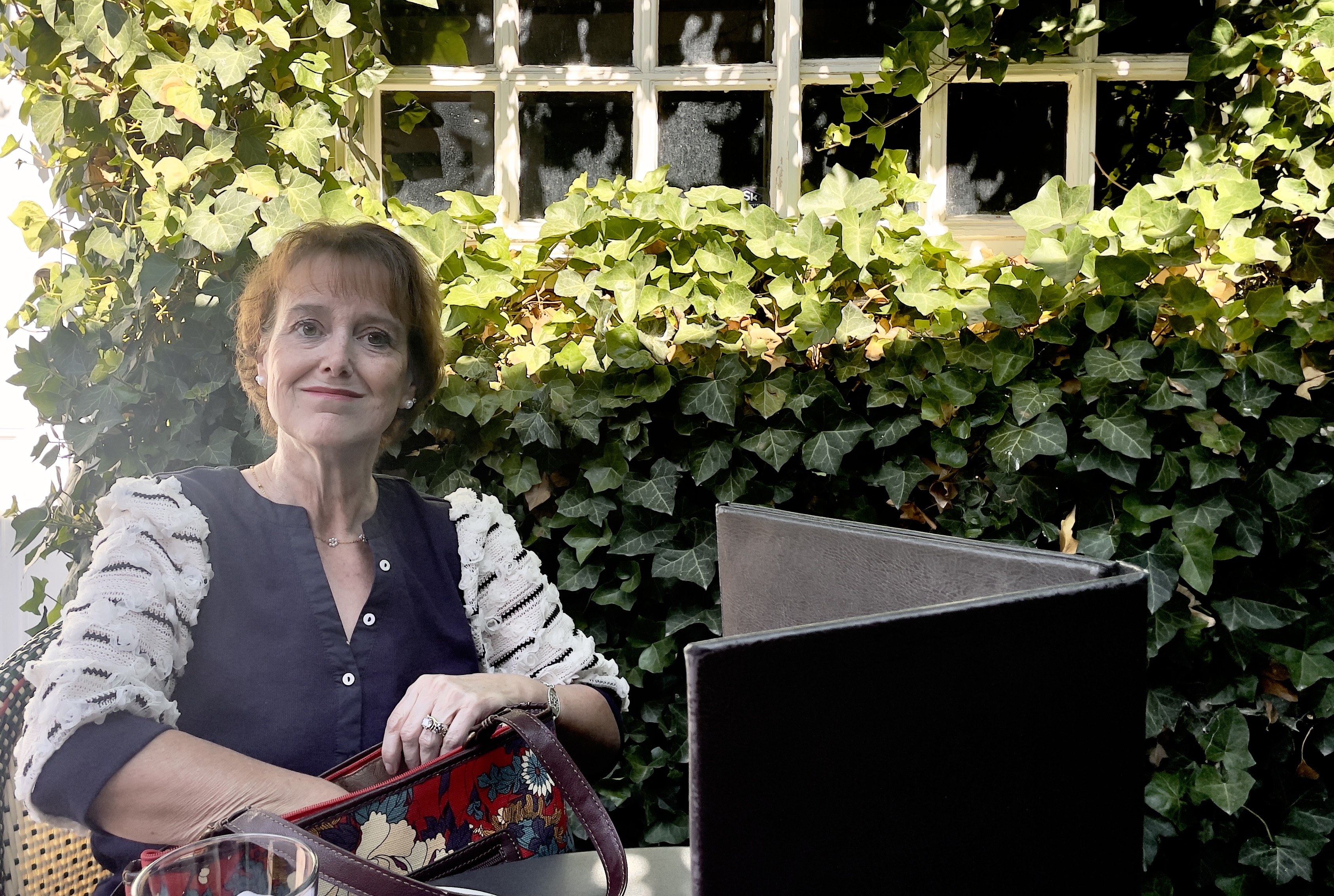
Finca specializes in Spanish cuisine, so its menu follows the small plate format. The Pintxos section includes the smallest plates, then the Tapas section has medium plates, and the largest dishes are in the Platos section, though all their dishes are served for sharing.
We began with a pintxos serving of olives. This came in a cast iron dish with a small ramekin for discarded pits. The dish contained a variety of olives, mostly green, some with a slight, brownish tinge. They were warmed with citrus, thyme, and garlic.
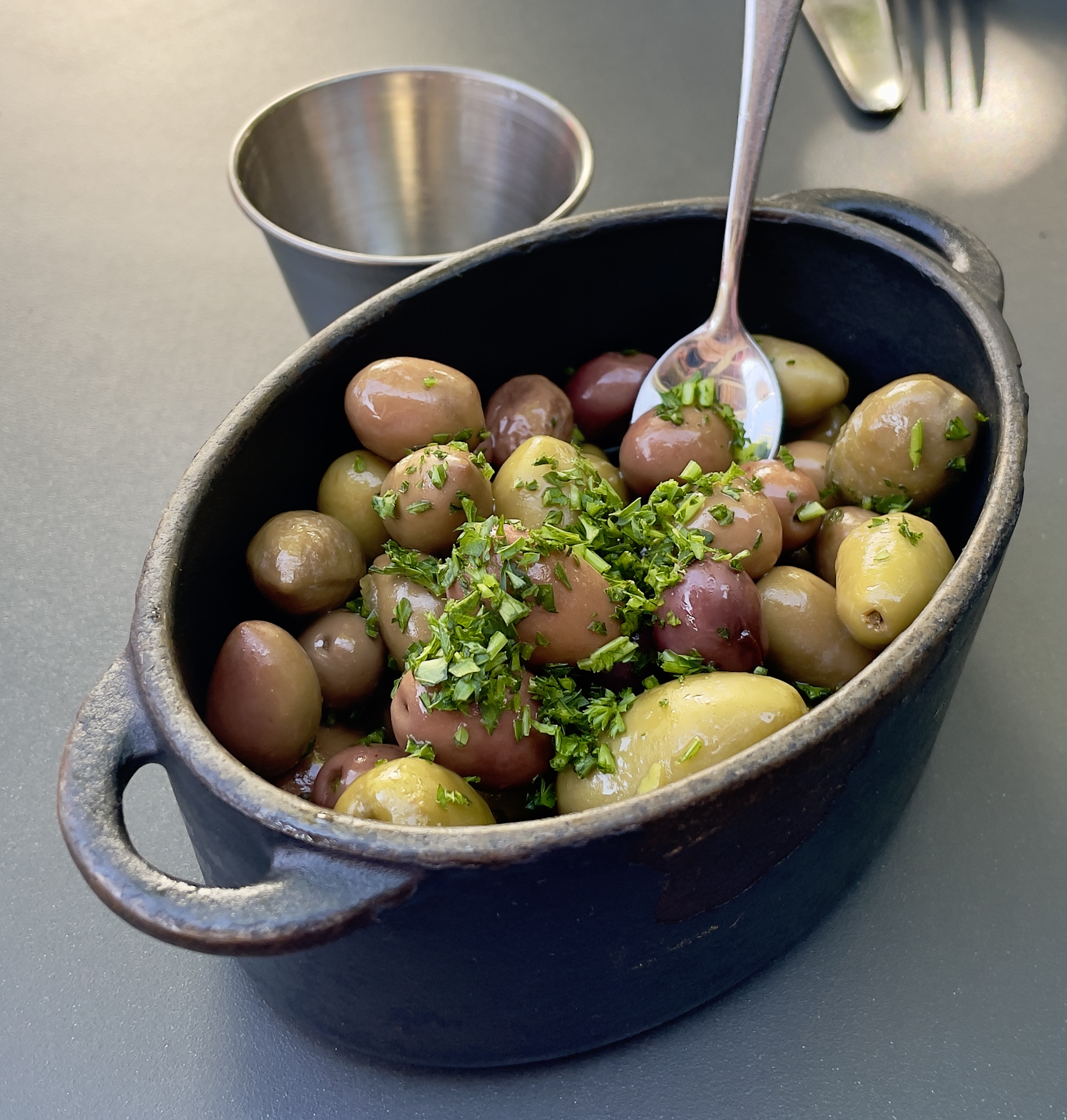
Our next pintxos selection was the plato de queso. Two slices of Manchego cheese were paired with crostini, house-made pickles, and membrillo. The pickles were a bit spicy. It kind of fooled me because the heat blended with the vinegar, but I warned Kathy about them. The spiciness was pleasant to me, while the acid was nicely balanced. And the membrillo? I’ve always loved quince, so I knew I would enjoy this, and I did.
We ordered a couple of pinchos morunos from the tapas section. These Moroccan lamb skewers were priced per skewer, which was nice as we could get one each and not have to fight over the extra one1. The skewers were smothered in a cucumber-yogurt sauce that was nicely but subtly enhanced with mint and other herbs.
The traditional albondigas also came from the tapas menu. These beef and pork meatballs sat in a bath of tomato sauce and were topped with melted Manchego cheese. The sauce was naturally sweet and tasty, but it lacked distinctive seasoning. I know Kathy wouldn’t have liked it to have a kick of cayenne pepper, but I hoped to find something to give it more character. The meatballs came with a couple slices of grilled crystal bread. Crystal bread, sometimes called “glass bread,” is a traditional Catalonian bread known for its shatteringly crisp crust and airy interior. This bread toasted well and was great at scooping up the tomato sauce.
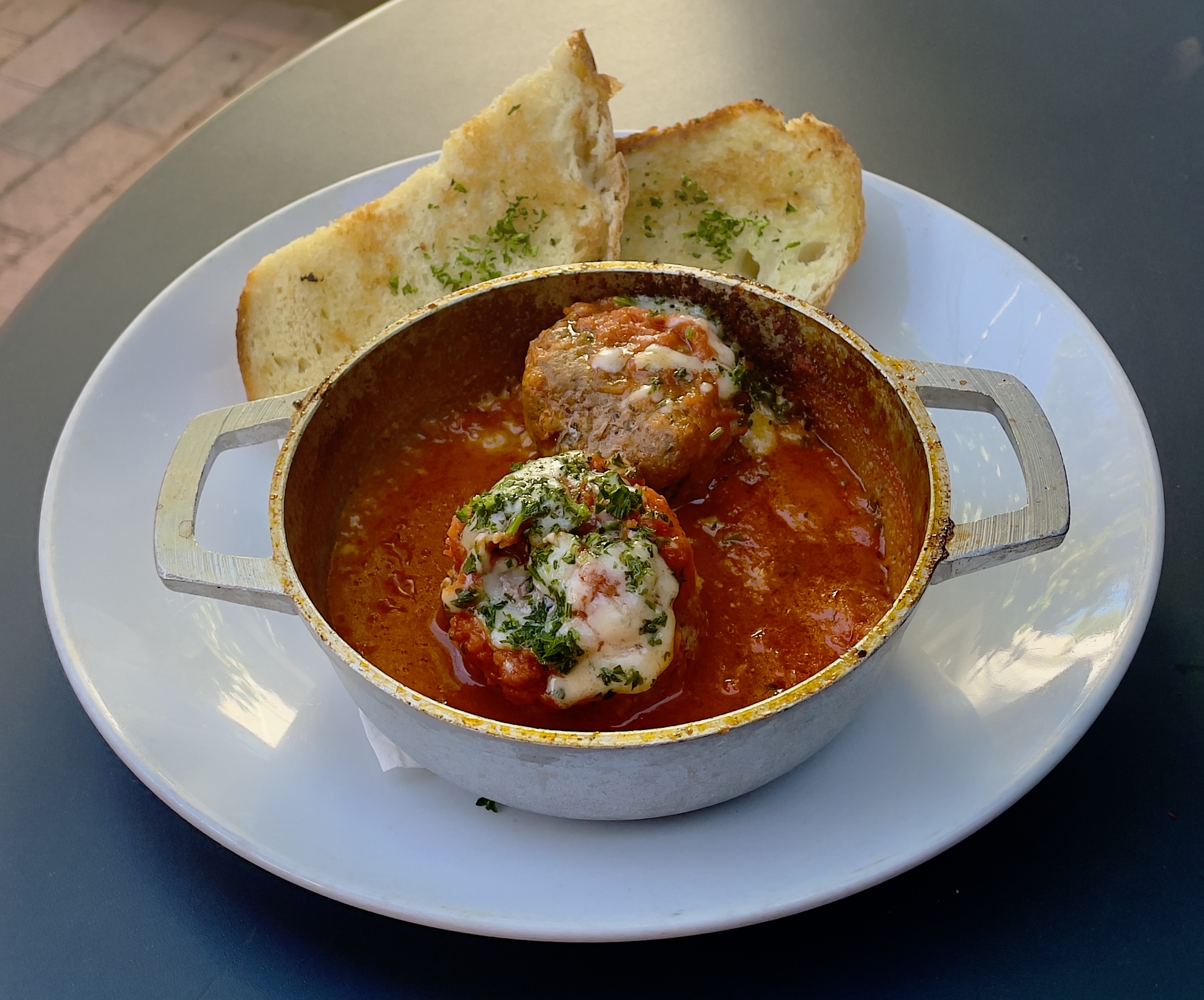
Our final selection came from the Platos menu: the paella de Valenciana. In my experience, paellas in North America tend to be seafood dishes. In fact, I once thought that paellas without seafood must be vulgar substitutes. However, paella purists will tell you that authentic paella is made with poultry or rabbit2. But if you want to get really historical, paella was originally made as a lunchtime meal for farmers and laborers. They would use whatever ingredients were readily available. That often meant rabbit or duck, chicken perhaps a little less so. For special occasions, they would use rodents, namely water voles. I think we can probably all be glad that particular ingredient has fallen out of favor.
At Finca, it doesn’t matter whether you are a paella purist or not. They offer three varieties: a vegan paella de setas, with mushrooms, the paella de Valenciana, with chicken and chorizo, and the paella de mariscos, with a variety of seafoods. We chose the paella de Valenciana. It came in a paellera, its frying pan, still hot from cooking. The bomba rice was delightful. This short-grain rice plumps nicely when cooked, soaking up all the great flavors. It also crisps nicely at the bottom of the paellera. I made sure to scrape all the goodness from the bottom of the pan. The dish had a strong saffron flavor. To be honest, I usually use saffron more for its color than for its flavor, so this was interesting to me. It had a deep, earthy taste that nicely complemented the smokiness of the paprika.
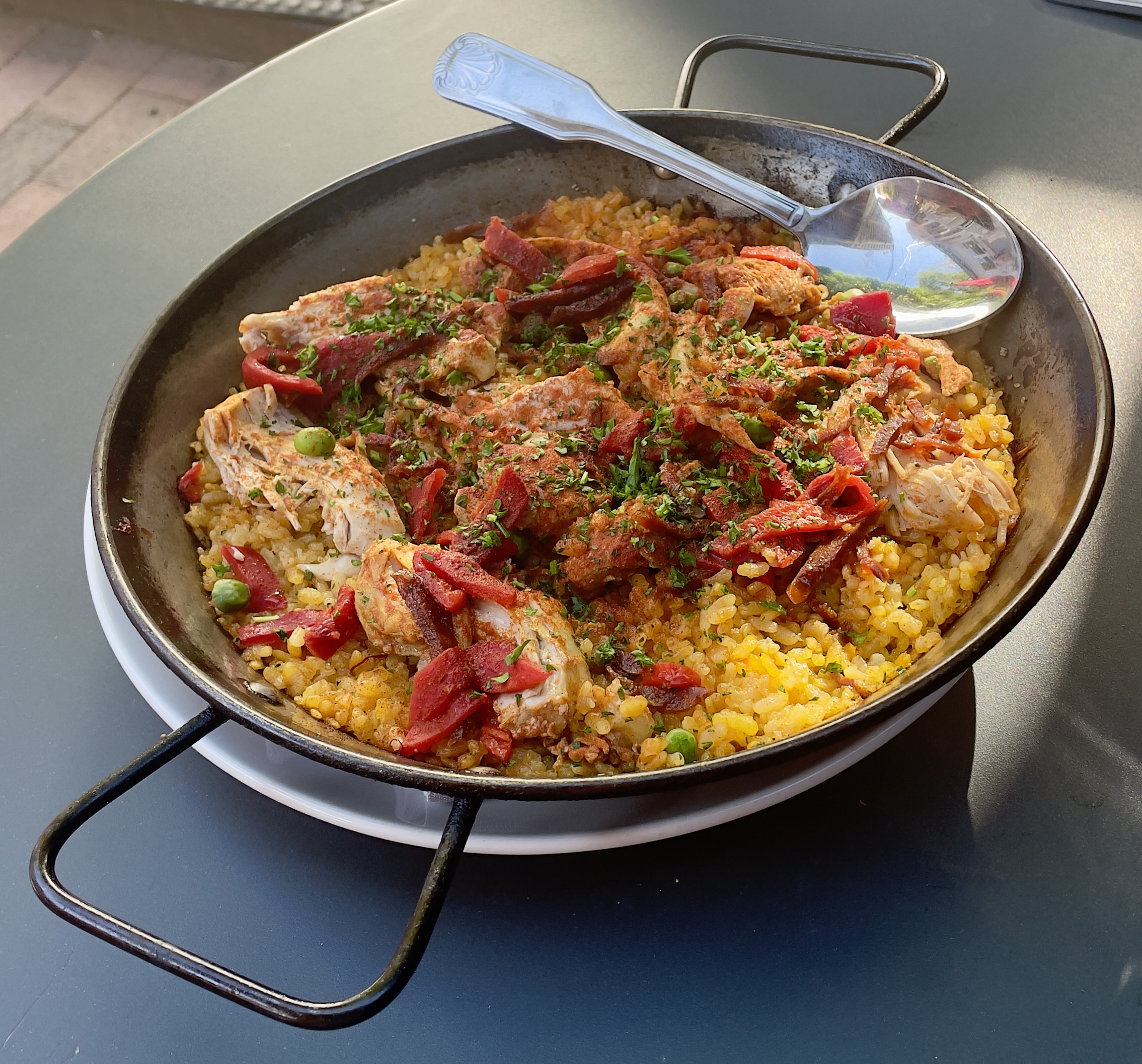
Before I left, I had them box up a torta de Santiago to try later. This almond cake came with a side of whiskey sauce. I don’t know that the sauce did anything to enhance the cake’s flavor, which I thought was already just fine. The moist cake was heavier than many, but not overly so.
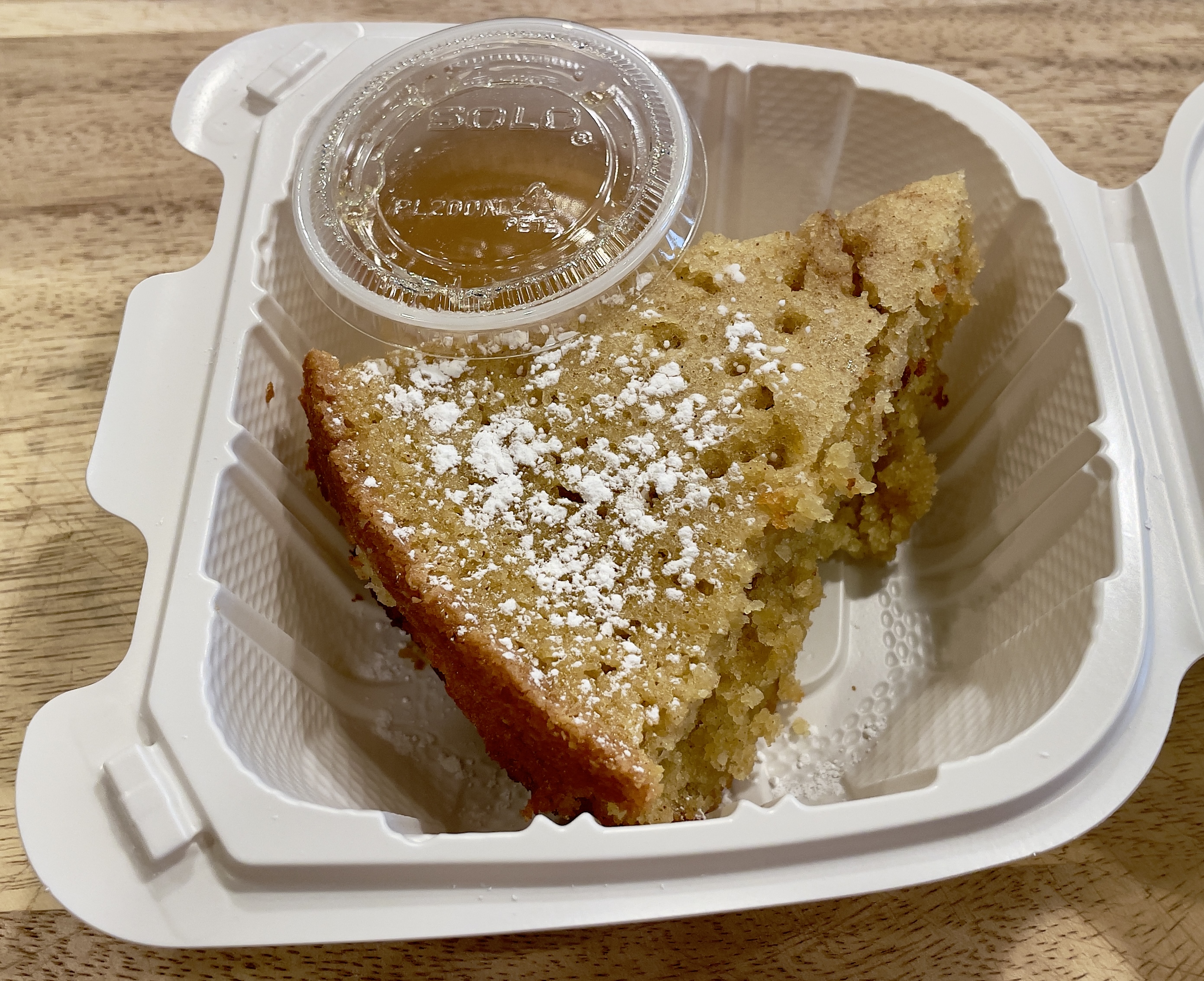
She said:
In the mood for some Spanish-inspired tapas, Brian and I headed up to Finca. It’s located on a beautiful tree-lined street, surrounded by wonderful turn-of-the-century Victorian, Craftsman, and Arts-and-Crafts houses clad in red brick and various types of trim. Flanking Finca are the King’s English Bookshop and the Mazza Restaurant. Across the way, a neighborhood wine bar, called Casot, was alive with chatter and laughter.
We arrived early and sat on a bench outside of the bookshop, enjoying the warmth of the sun in the light breeze. The sounds of happiness coming from Casot put a smile on my face. So did watching people riding their bikes, walking their dogs, or popping into the King’s English to pick up books.
I couldn’t see the restaurant, so I asked Brian where it was. He said, “Right there,” but I still couldn’t see it. It’s because it’s set back from the sidewalk, accessible through a brick-lined path under an archway covered with ivy. Once we got past that, we walked up a few steps and encountered a hostess standing at a wooden credenza. Turns out we were standing in the section of the restaurant that features the outdoor patio seating. The indoor seating was inside the adjacent building.
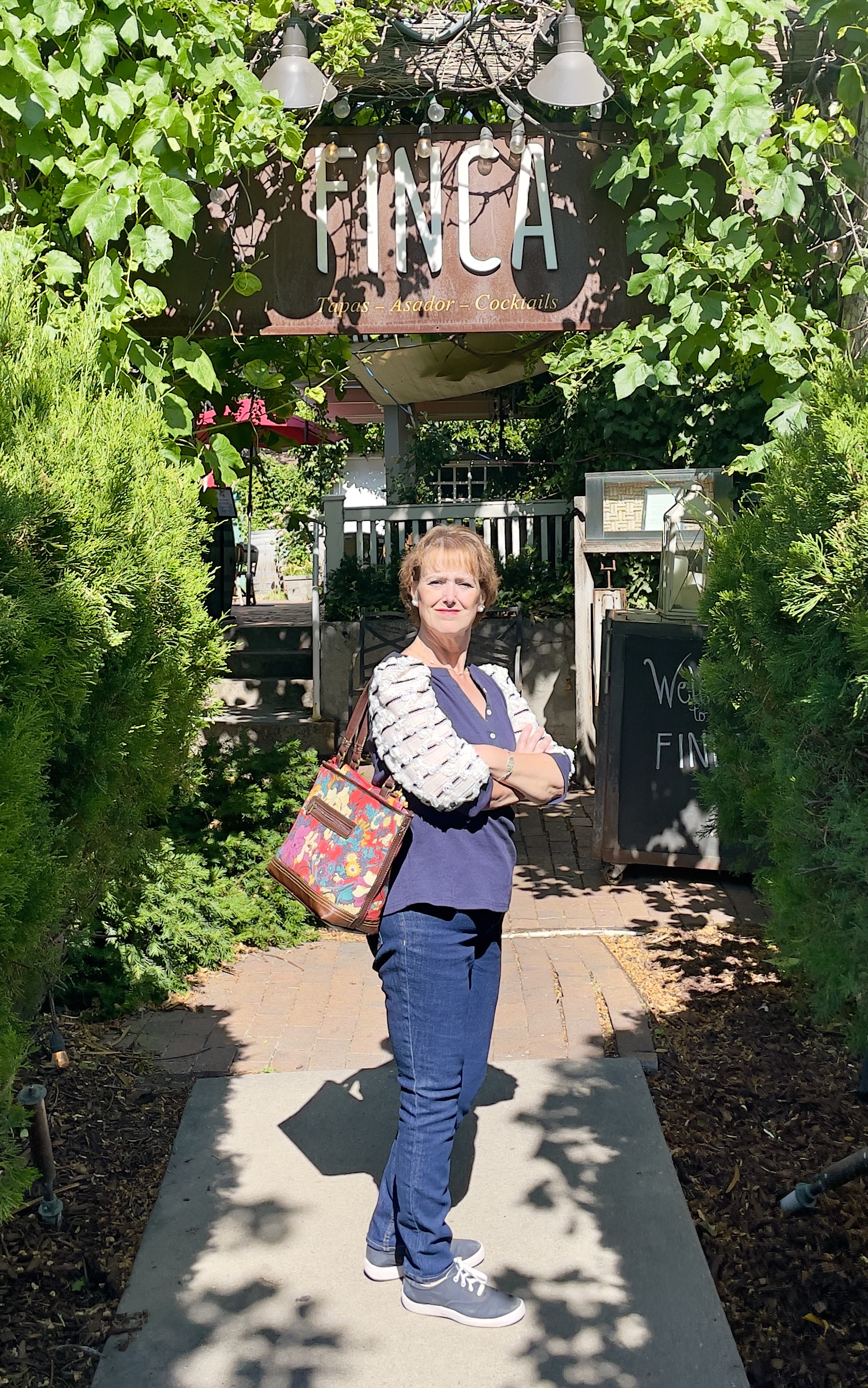
Anyway, the hostess led us to a table in the far corner of the patio area. Once I was settled in, I took stock of our surroundings.
Red brick floor. Round and square metal tables with rattan chairs in assorted colors (beige, green/cream combo), overhead canopies for shade, red rose bushes, pink hydrangeas, yellow daisies, a long wall that was originally a white lattice fence but now completely covered in ivy, seating partially protected by a pergola, and a red patio umbrella.
With our table tucked into a cozy, ivy-laden corner, the vibe was relaxed and intimate. Contributing to the comfortable ambiance was the restaurant’s playlist. Brian didn’t exaggerate when he said I sang along to every song. Maybe there are some from my generation who can resist Tom Jones crooning “She’s a Lady” or Looking Glass smoothly singing “Brandy (You’re a Fine Girl),” not to mention tunes from Elton John, Fleetwood Mac, Lionel Ritchie, .38 Special, America, and other musical icons from the 70s and 80s. I was in the zone! 😊
Now, about the food:
I began with a beverage, the “Mocktail Roulette.” The waitress asked what kinds of flavors I like, if I didn’t like anything, and then surprised me with a bespoke concoction. It included citrus and sangria flavors with a ginger beer base. Delicious!
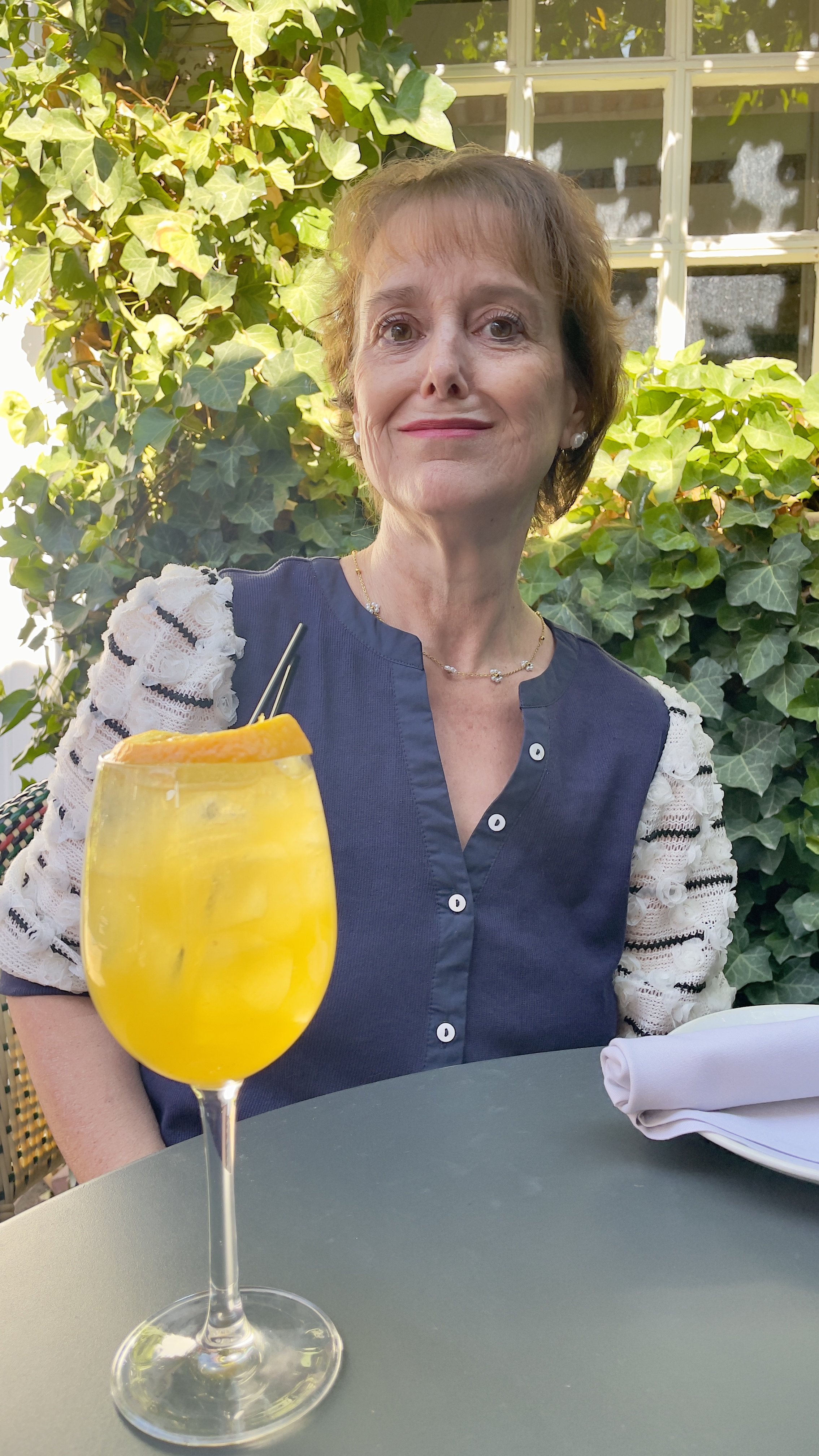
Next up were the olives, which were a nice way to start. I appreciated their earthiness and briny tones. I am partial to olives. Weirdly, though, I’d never eaten black olives until moving to the U.S. Prior to that, the only olives I’d ever been exposed to were bottled green olives with red pimentos in their centers. (Maybe it’s an Eastern Canadian thing?)
Next, we were served the plato de queso. The Manchego cheese and membrillo were excellent, but I burned my lips on the pickle slices and I passed on the crostini.
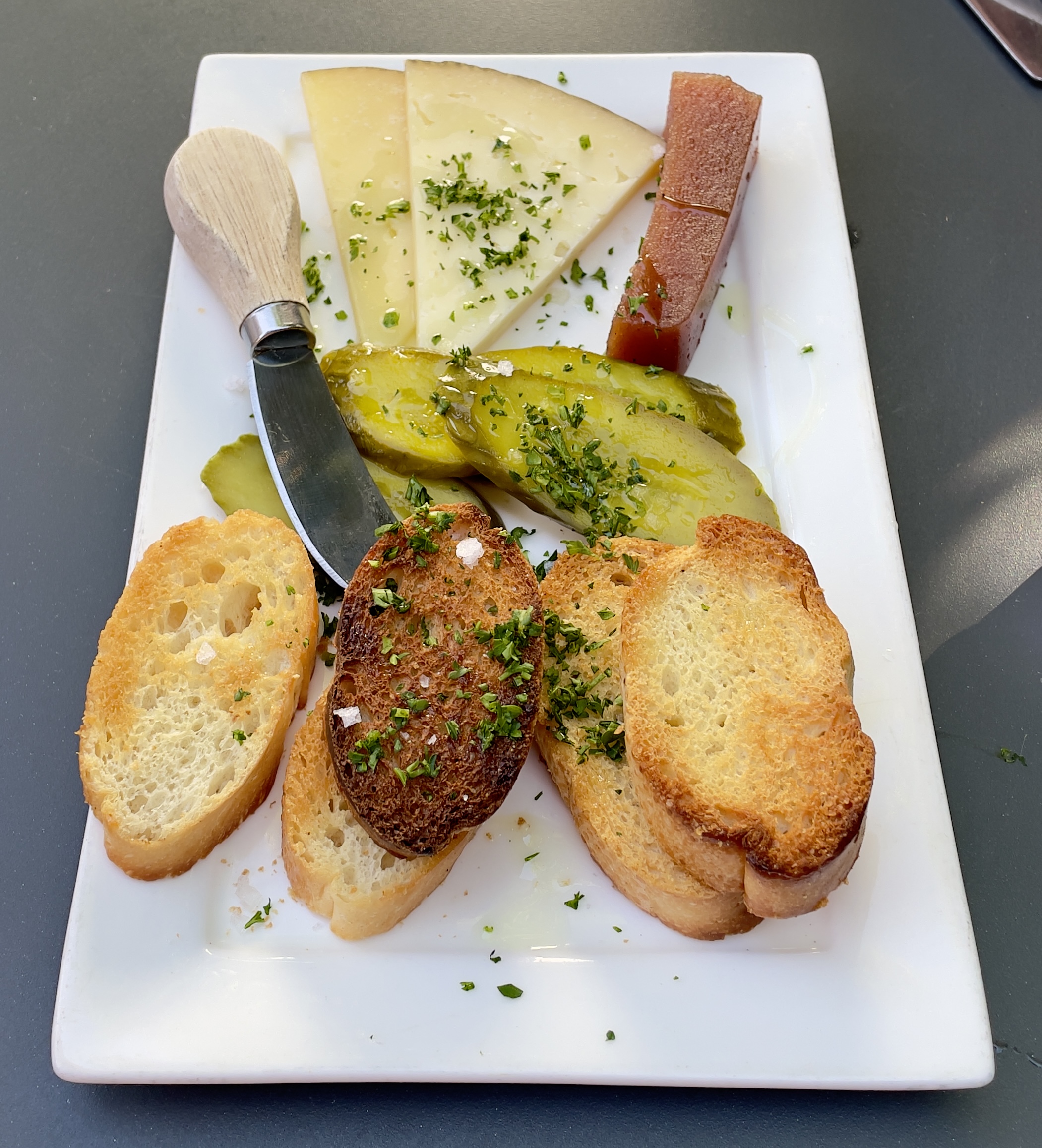
The Moroccan lamb skewers followed. The lamb meatballs were good, but the yogurt and mint sauce served with them really enhanced the meat.
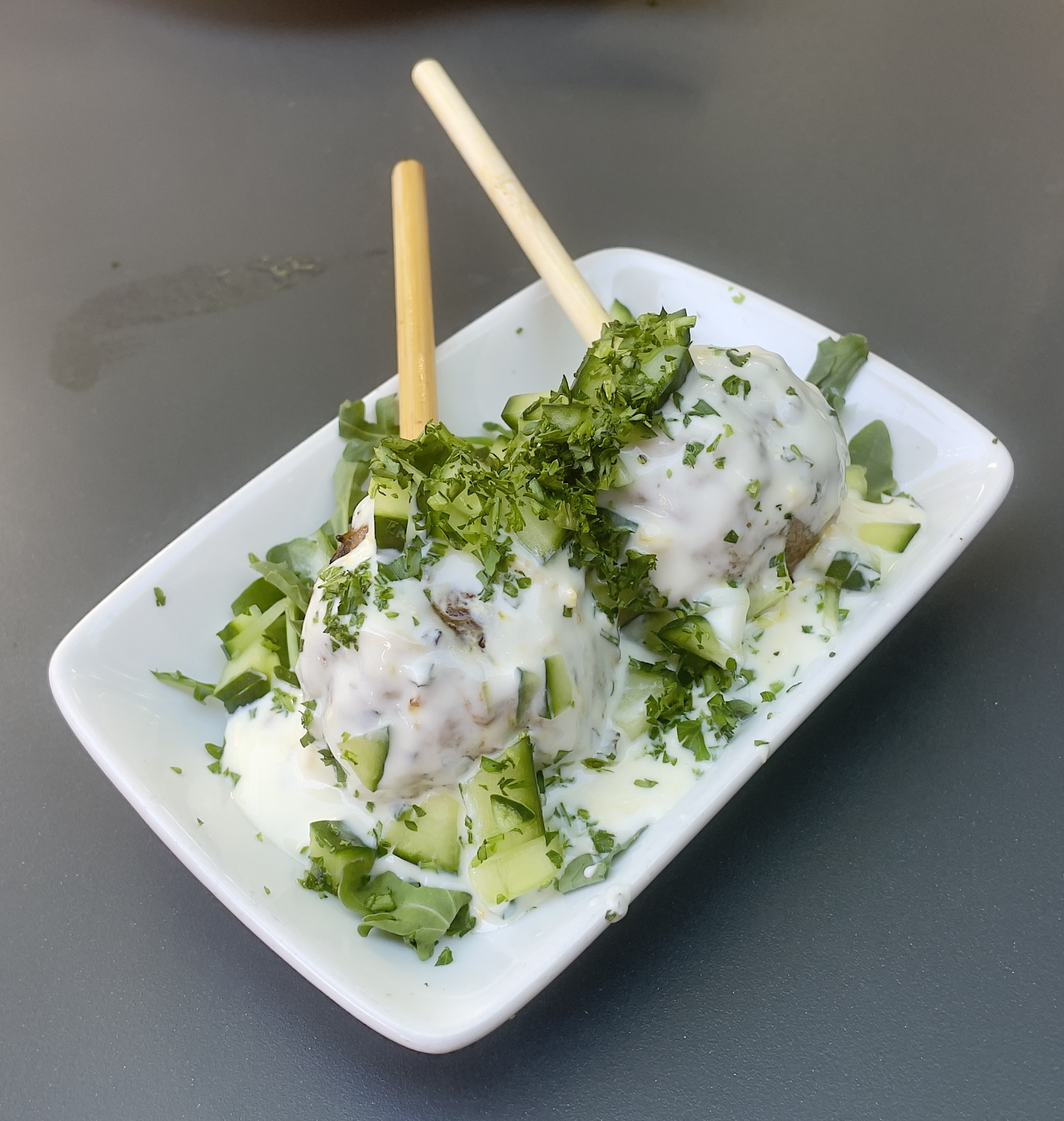
In addition to the lamb meatballs, we also ordered the beef and pork variety that were listed on the menu. Those came with a tomato-based sauce. Although they were moist, I found them lacking in flavor. They could have been improved by a zesty seasoning of some kind.
Lastly, the paella de Valenciana came served in the skillet in which the dish had been cooked. It looked appetizing, but again, it seemed to be missing a couple of spices. I could taste the smoky paprika—which my taste buds appreciated—but the saffron was a bit too overpowering for me, personally. Also, the rice and chicken were a bit dry. I prefer paella with some sauciness and moisture to them.
Don’t get me wrong. The food was good and attractively presented, but some of the dishes could have been pushed to the next level with additional spices. I wanted my taste buds to do the flamenco, not the waltz.
Conclusion:
Looking for a cozy spot to enjoy shared tapas while listening to great 70s’ music? Give Finca a try!